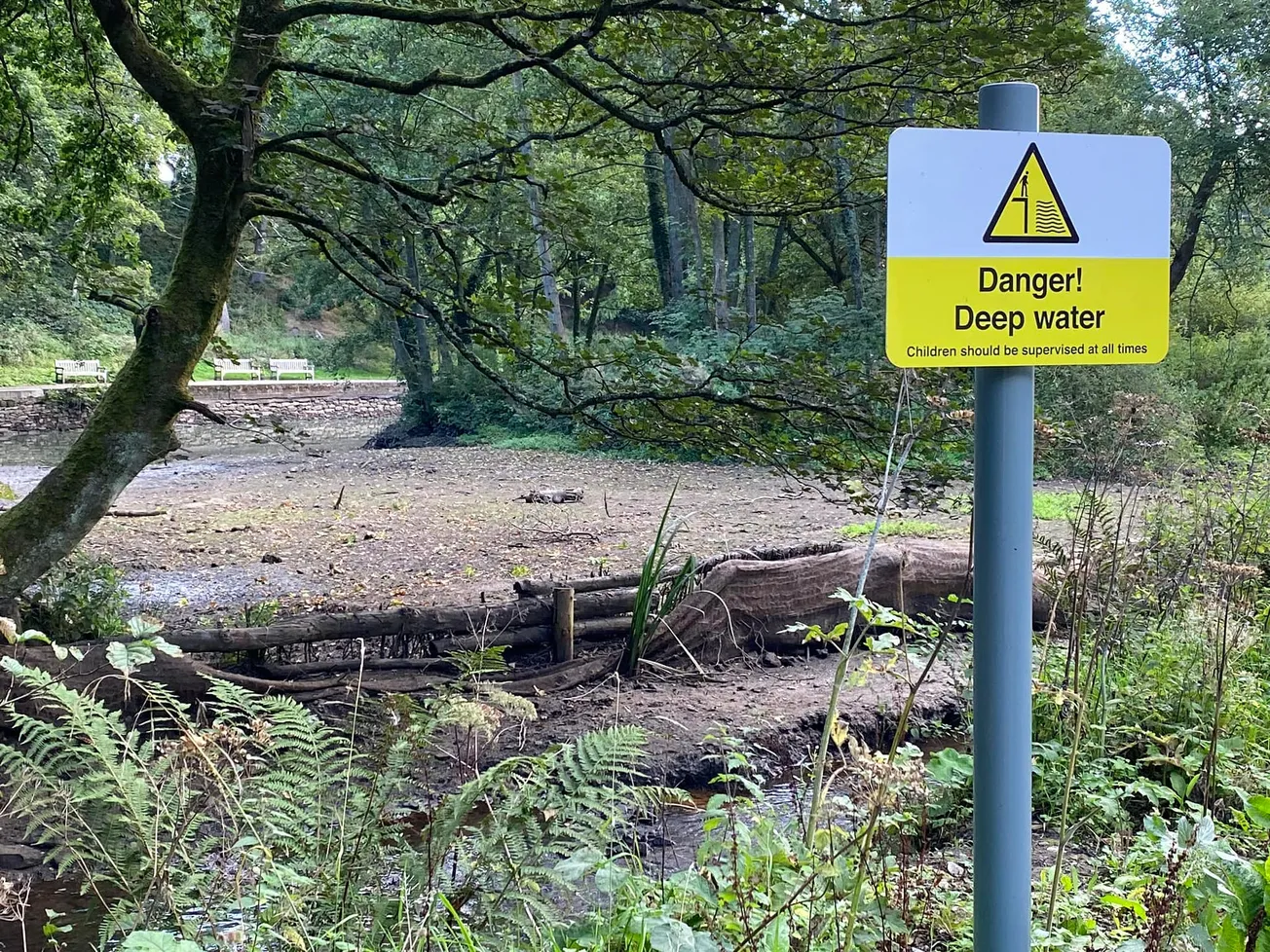“It’s had getting on for a million pounds spent on it and it’s in a worse state now than it was before they started. I just feel that that can’t be right.”
In the grand scheme of things, a silt problem does not sound like the most pressing of issues. It is not a nuclear apocalypse or a forest fire; it sounds like something a person might spend a harried half hour fixing. But in the case of Forge Dam, an 18th-century millpond turned 20th-century boating lake in Fulwood, it has become a threat to its very existence, so I am going to have to ask you to care about silt. When we talk about a silt problem in the context of Forge Dam, we are talking about the fact it is slowly being filled up with sediment being carried by the River Porter down the valley. If this issue was not resolved, the lake could eventually disappear.
I’m being shown round Forge Dam by local resident John Belk, who lives in one of the former mill workers’ cottages which overlook the dam. Over the past two years, he and his neighbours have watched on with increasing concern as restoration work aimed at fixing the problem hasn’t been going to plan.
Typically, on the day I’m visiting, the heavy rain of the last few days means the lake looks like it’s full of water. But in normal weather conditions the lake looks very different to today — and remarkably similar to how it looked before any work took place. The work was meant to free the lake up from its slow strangulation by sediment, but according to John it hasn’t had the desired effect. “The silt is still really high on one side so the lake just looks empty,” he tells me. “There’s just silt and there’s no water. It just looks like it’s full of mud.”

The work began in October 2021 and was initially meant to last just three months. However, by the time the work was finally “completed” 18 months later, the whole area around the dam, which is also in a conservation area and sits within Sheffield’s precious Green Belt, was trashed — the margins of the lake had deteriorated into a series of mud baths. “The work just caused havoc, it was shocking,” John tells me. “It was like the Somme around it. It was awful.”
But as well as being disappointed about the impact of the work and the way Forge Dam lake currently looks, John is also angry that a large amount of public money seems to have been wasted. “In a cost of living crisis when Sheffield Council is about to go bankrupt, the sums of money we’re talking about are unbelievable,” he says. “We don’t understand why there has been no accountability.”
It’s all a far cry from what was announced two years ago. Back in August 2021, Sheffield City Council said the restoration project would “rejuvenate” the heavily silted millpond at Forge Dam. The work would “carefully remove and re-profile decades of silt, creating a mosaic of deep and shallow water”. By working with environmental specialists, the project would provide a “twin pronged nature-based solution” to reduce future sediment in the valley. This would be done by first slowing the flow of the River Porter as it approached the dam utilising natural flood management techniques. And secondly, by the “sensitive installation” of a natural porous barrier to encourage the main flow of the river away from the lake and over the weir.
According to a Freedom of Information Act request lodged earlier this year, in total, £767,425 has been spent on the Forge Dam restoration project over the last two years. Of this, Friends of Porter Valley contributed £261,000, made up of around £150,000 in donations and around £100,000 which was left to the campaign in a will. To this already substantial amount was added £247,000 from the government’s Green Recovery Challenge Fund, and £84,682 in so-called Section 106 and community infrastructure levy funding — money that developers are asked to contribute to local projects in return for planning permission.

The extra £174,743? Well, the same Freedom of Information request reveals the council’s parks and countryside department contributed £55,000 in 2021 after storms in November and December caused “significant damage and resulted in contract extension and cost increases”. And the council’s facilities management department also contributed £120,000 in 2022 towards “associated access path works”, and to fix the partial collapse of the lake wall.
Whatever has happened at Forge Dam, as John Belk says, £750,000 is a lot of money to spend for a bad job — or half a job. John tells me that as soon as it hasn’t rained for a few days, the lake level drops drastically, exposing the mountains of silt the restoration work was meant to remedy. While it’s been many years since anyone boated at the lake, thousands of people still use the popular beauty spot every week. It’s difficult to imagine anyone wanting to walk up the Porter Valley from Endcliffe Park to look at what is effectively now a huge pile of mud. Restoration work which was billed as returning a Sheffield beauty spot to its former glory has ended up making it an eyesore.
There is a consensus amongst everyone I’ve spoken to that the restoration work hasn’t gone to plan. However, opinions diverge when I try to ascertain what exactly has gone wrong.
The contractor chosen by the council, after a competitive bidding process in late 2021, was the Gloucester-based environmental consultant and contractor Sanctus, who say they have worked on some of the UK’s “most challenging brownfield and blue/green infrastructure programmes and projects”. A page on their website goes into great detail what they did at Forge Dam. When you look at the claims next to dozens of pictures of the site I’ve been shown of the still silted lake, it feels as if you’re interviewing someone who lied on their CV.

“Through Sanctus’ philosophy to work sensitively within the environment, the works were completed without major disruption to the local flora and fauna and involved the local community,” the webpage says, in a tone of self-congratulation I’m not sure the work it’s describing merits. “These works will help deliver and preserve environmental, ecological, and social value throughout the Porter Brook Valley for many years to come.” The page goes on to say the scheme was “highly commended in the Brownfield Briefing Awards for the Best Community Engagement as well as Wining (sic) Best Remediation of a Smaller Site a true reflection on Sanctus’ commitment to environmental betterment”.
When I spoke to him earlier this week, Sanctus contract director Alex Willison told The Tribune that much more silt could have potentially been taken out of the lake, but that complete removal wasn’t possible with the amount of money they were given by the council and the Friends group. He added that when work was carried out, due to its age the dam was in “an element of disrepair”, meaning that when the silt was removed the structure became “quite porous”. It is this that means that the lake drains away rapidly when it isn’t raining, meaning that at times it can look worse than if no work took place at all.
For Friends of Porter Valley (a charity set up to look after the valley and its leisure and heritage sites), the restoration work was the culmination of a fundraising effort that had taken them a decade. As well as the beautiful wooded valley itself, the Friends of Porter Valley knew that there were two important heritage sites within it. One was Shepherd Wheel, a 16th-century water-powered grinding workshop which was restored around 12 years ago using money raised by the Friends and supplemented by the council. The other was Forge Dam, which was silting up very fast and was going to disappear if nothing was done about it.
“There was a petition and the public were complaining,” FoPV chair Ann le Sage tells me over the phone earlier this week. She accepts that the current state of the lake isn’t what anyone wanted but is insistent that things have improved at the site since the restoration work. “We definitely wouldn’t have wanted it to carry on looking the way it did four years ago,” she says.

The work was billed as a way of returning the lake to the way it was 50 or 60 years ago, when Forge Dam was used as a boating lake by the people of Sheffield. Before that it was owned by wealthy industrialist Thomas Boulsover, best known as the inventor of Sheffield plate, who used the millpond to drive his water-powered rolling mills. These multiple layers of history and heritage make the valley unique, Ann le Sage tells me. “The Porter Valley had 19 water mills and is where Sheffield came from,” she says. Now those “Satanic metalworking mills” have gone silent, she says the valley is returning to its naturally beautiful state.
For FoPV, the desilting element of the project went entirely to plan. 5,000 tonnes of compacted silt was taken out and transported to Beighton to act as the cap for a landfill. However, damage caused to the dam during the restoration work has caused it to leak, meaning water runs out and the lake often looks as badly silted as ever. “When it’s not raining, the brook drops down through the hole under the spillway and that means the whole bloody level drops,” she says. “It's not what we expected. It’s not the way we expected it to look.”
Who is to blame for the problem isn’t clear, or really even if anyone is to blame at all. Ann says it’s a “complicated situation” but other than that doesn’t want to go into too much detail about it. She says more may come out about what happened in the future, but opts not to elaborate. “We persuaded the council it should be done and spent 10 years raising the money,” she tells me. “I wanted people to see it right. And it’s not right.”
One former site worker who spoke to The Tribune on condition of anonymity said Sanctus’ operation left a lot to be desired. He alleges the water pumps they used weren’t up to the job, meaning that the site actually flooded three times while he was working there. Each time this happened the lake needed draining again and work needed to stop. The worker also claimed the weight of the extracted silt being carried on the bridleway led to damage to the path, leading to even more delays. “It just wasn’t a very professional job,” he told us.

John Belk agrees. On our trip around the site on Thursday morning, he shows me extensive damage to trees and a Victorian fence on the bridleway. He also says the crushed building material that was put down to fix the path after the work was completed is completely unsuitable and is filled with tile, glass and plastic. “If you’ve had a bad builder, you go to the bottom of the garden to uncover all the rubbish they’ve left behind,” says John. “That’s exactly what you’ve got here.”
But the bigger problem is the lake, or more accurately the lack of it. John tells me you can tell not enough silt was taken out by Sanctus by the fact that several muddy bridges can still be seen joining the island — which was meant to become a separated wildlife haven — to the mainland. “One of the Sanctus staff told me that they should have taken out another 3,000 tonnes on top of the 5,000 they took out,” he says. He adds that the so-called “training wall”, which was meant to channel the main flow of the Porter down one side of the lake and away over the weir, thereby reducing the rate at which the river deposits silt in Forge Dam in the future, isn’t working either. In Sanctus’ design prospectus, they said the wall would be “discrete”, but when I visit and the lake is full it can clearly be seen sticking out of the water. When the water level is low it looks like some kind of prehistoric settlement has been exposed on the lake bed.
During the course of our conversations, both John Belk and Ann le Sage tell me the person I really need to speak to is Claire Watts from Sheffield City Council’s parks and countryside department, who is the lead council officer looking after the project. Earlier this week I agreed to meet Claire at Forge Dam on Friday morning, only to be told by the council’s press office that this isn’t protocol. Instead I’m given a pre-prepared statement from the relevant committee chair, and no opportunity to ask further questions.

Councillor Richard Williams, chair of the communities, parks and leisure committee at Sheffield City Council, told The Tribune that the de-silting project at Forge Dam had revealed a historic sluice gate through which water has been “running freely” since the completion of the restoration works. He added that during rainy weather, enough water comes into Forge Dam to keep it filled, but that in “extended dry weather”, the water levels drop.
“Wildlife in the downstream environment benefits from this continual flow of oxygenated water,” he continued. “So we’re already working to find a solution which allows us to control the flow through the historic sluice to achieve a win-win, where we benefit wildlife downstream without negatively impacting on visitor experience at Forge Dam.”
Whether the breached sluice gate is the only problem with the restoration is debatable. And “already working to find a solution” doesn’t feel too hopeful for those who live near or regularly visit Forge Dam either. For John Belk, while the lake and its surroundings have improved over the last two years, it’s a “huge disappointment” that important restoration work on a key heritage site has been spoiled by what he sees as a lack of management and poor supervision. “It was meant to be a gentle conservation job,” he tells me. “But it’s turned into a botched builder’s job.”

Comments
How to comment:
If you are already a member,
click here to sign in
and leave a comment.
If you aren't a member,
sign up here
to be able to leave a comment.
To add your photo, click here to create a profile on Gravatar.







